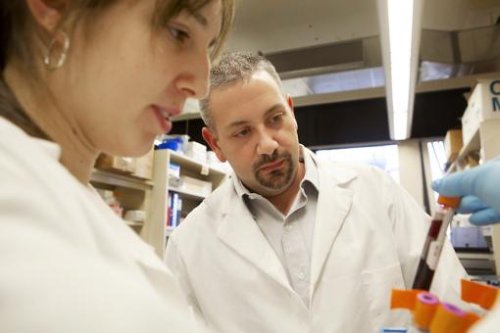Blood test may find markers of bladder cancer risk
Blood test may find markers of bladder cancer risk
Exposures to harmful substances in the environment alters the methylation of DNA, potentially elevating the risk of developing cancer. A new blood test can detect the abnormal pattern of methylation associated with bladder cancer, suggesting that it may be possible to assess a person’s susceptibility to the disease.

- A marker for toxic exposures Carmen Marsit, with lab assistant Alison Migliori, hopes methylation patterns can be effective in prediction or diagnosis of bladder and other cancers. Credit: Mike Cohea/Brown University
PROVIDENCE, R.I. [Brown University] — Knowing that it is impossible to catalog all the carcinogenic exposures a person has had in life and then assess them, Brown University researcher Carmen Marsit is looking for a more precise way to predict individual susceptibility to cancer. In a paper published online Feb. 22, 2011, in the Journal of Clinical Oncology, Marsit leads a team of scientists in describing a blood test that can accurately detect biomolecular markers of bladder cancer that risky exposures may have left behind.
The test measures a pattern of “methylation,” a chemical alteration to DNA that affects which genes are expressed in cells, that Marsit’s team determined is associated with bladder cancer. Methylation is affected by exposures in the environment, such as cigarette smoke and industrial pollutants, so many scientists believe that abnormal patterns of it in the body could be indicators of an increased likelihood of disease.
“What we might be measuring is an accumulated barometer of your life of exposures that then put you at risk,” said Marsit, assistant professor of medical science in the Department of Pathology and Laboratory Medicine at the Warren Alpert School of Medicine at Brown University. “Will you ever really figure out if eating something when you were 12 gave you cancer? Instead we can use these kinds of markers as an integrated measure of your exposure history throughout your life.”
Prediction or early detection?
To create the test, Marsit’s team of scientists at Brown and Dartmouth studied the blood of 112 people who had bladder cancer and 118 who didn’t. That gave them the tell-tale pattern of methylation to look for in immune system cells in the blood. Then, under properly blind conditions, they applied that test to the blood of a similar number of people who either had the cancer or didn’t, and made their predictions.
They found that they could indeed determine who had the cancer and who didn’t, based solely on the methylation pattern they observed. Controlling for the exposure to known risk factors like smoking that the patients reported, the researchers saw that people with the methylation pattern were 5.2 times more likely to have bladder cancer than people who did not have the pattern.
Because the samples used in the study came from people who already had the cancer, Marsit acknowledged that the scientists cannot be sure without further research whether the methylation markers in their immune system cells were predictors of cancer (i.e., they were present before the cancer began growing, as the team’s hypothesis suggests) or simply indicated that the cancer was already there (i.e., they are a consequence of the cancer).
At a minimum, the study proves that the cancer is associated with a methylation pattern that can readily be detected in the blood, Marsit said. For cancers that are buried deep in the body and are therefore hard to detect, such as bladder cancer, a minimally invasive test that provides either prediction or early detection of cancer could make a big difference in improving a patient’s prognosis, he added.
The researchers in the paper write that testing for methylation in blood cells could also be similarly applicable to other cancers.
Other authors in addition to Marsit include Brown researchers Devin Koestler, Brock Christensen, Andres Houseman, and Karl Kelsey, and Dartmouth researcher Margaret Karagas.
The study was funded by the National Institutes of Health and the Flight Attendants Medical Research Institute.
* The above story is reprinted from materials provided by Brown University
** More information at Brown University (Providence, Rhode Island, USA)




















